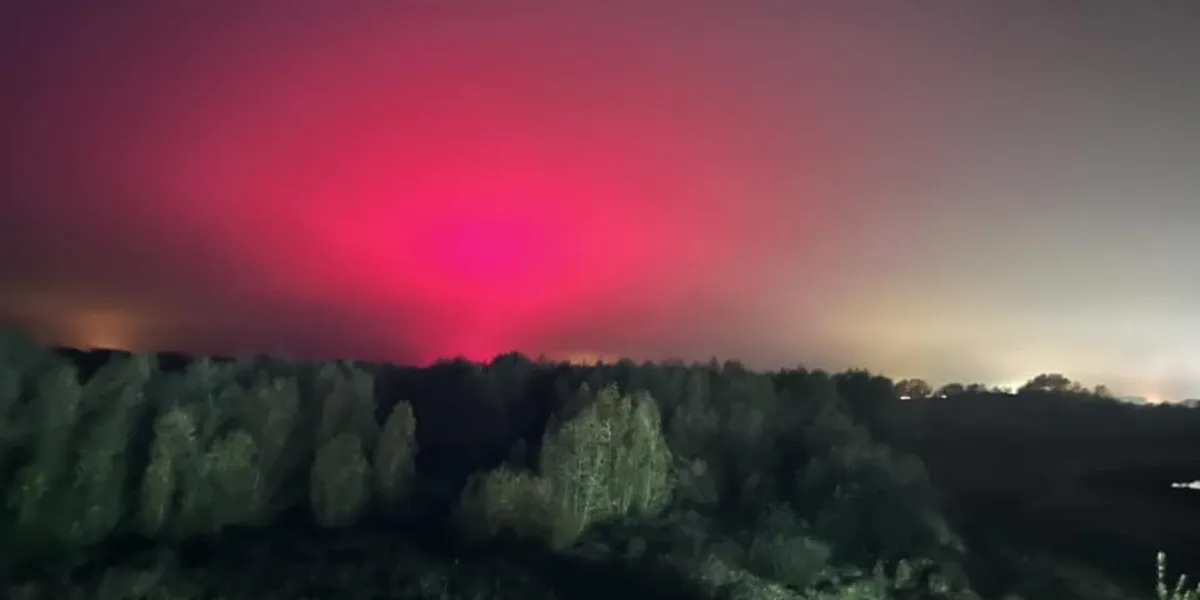Dee Harrison, a resident of Ipswich, recently shared a series of images that seemed to capture an ethereal aurora in the skies above Bramford, Suffolk. However, the reality behind these colorful lights was rather surprising, rooted not in celestial phenomena but in modern horticulture.
This unexpected twist has charmed many, sparking curiosity about how the lights from a nearby tomato factory could create such a breathtaking display.
The Unexpected Northern Lights Encounter
It was early on a misty Wednesday morning when Dee Harrison, aged 56, found herself transfixed by a mysterious pink and red glow in the sky. Driving along Paper Mill Lane around 5:15 am, Harrison spotted what she thought could be the Northern Lights. “At first I thought something was on fire, but when I parked up, I could see this deep pink sky.
Through my phone camera, it looked even brighter, so I thought it was an aurora,” she shared. This illusion of an aurora delighted Harrison, who believed for a moment that she had stumbled upon a rare natural phenomenon, which she thought she had entirely to herself.
Read : UK Denies Visa to Nelson Mandela’s Grandson Mandla Over His Support for Hamas
The phenomenon was quickly shared on social media, where Harrison’s images drew attention and appreciation from those enchanted by the “impressive” display. Many shared in her initial wonder, admiring the captivating, colorful glow. Yet, the excitement was short-lived.
Read : Republican VP Pick Vance Calls UK ‘First Islamist Country to Get Nuclear Weapon’, Faces Backlash
While Harrison’s photographs resembled the Northern Lights, the glow wasn’t a result of geomagnetic storms or atmospheric particles interacting with the Earth’s magnetic field. Instead, it was the LED lighting from a tomato factory at Suffolk Sweet Tomatoes.
How LED Lights Create an Aurora-Like Effect
The remarkable glow in the early morning sky originated from the LED light units used at Suffolk Sweet Tomatoes. These lights are designed to stimulate plant growth, aiding the year-round production of tomatoes by creating a controlled environment for the plants.
Suffolk Sweet Tomatoes has adopted advanced horticultural technology to optimize growing conditions, enabling the tomato plants to thrive even during the UK’s darker winter months. This use of LED lighting, though common in greenhouse farming, isn’t typically known to cause visual effects on such a scale, leaving passersby puzzled by the radiant pink and red hues.

Adam Cotterell, a 34-year-old local from Somersham, is one of many who recognized the source of the glow. Cotterell lives just two miles from the factory and explained that the colorful lights are visible when specific weather conditions align. “Since the tomato factory has been there, you have always been able to see a red and pink hue in the sky when there is mist or fog in the air.
It is most apparent in the winter months on a cold foggy night,” he said. While the phenomenon remains an intriguing sight, Cotterell remarked that the glow produced by the factory’s lights simply can’t compare to the real aurora borealis, which he experienced in May 2024.
LED lights emit intense brightness, even in foggy conditions, causing the vivid colors to diffuse into the sky and create an aurora-like effect. On days when mist or fog linger, this light dispersion becomes particularly striking.
While unexpected, the tomato factory glow has a particular charm, especially during the damp, low-humidity conditions of winter. Though not a natural event, this glow illustrates how human activities can interact with nature in unexpected ways, sparking curiosity and excitement in local communities.
Real Northern Lights Make a Rare Appearance in the UK
Interestingly, Harrison’s sighting occurred only a couple of weeks after a real Northern Lights display was visible across parts of the UK. In recent months, the Northern Lights, also known as the aurora borealis, have appeared more frequently in the UK skies, partly due to one of the most intense geomagnetic storms since 2003.
Professor Sean Elvidge from the University of Birmingham notes that this increased visibility is a result of heightened solar activity, which produces more frequent geomagnetic storms.

Witnessing the true aurora borealis is an awe-inspiring experience, especially in regions like the UK, where such displays are rare. During a geomagnetic storm, charged particles from the sun interact with the Earth’s atmosphere, producing vibrant colors in the sky, ranging from green and pink to violet and yellow.
Cotterell recalls watching the real aurora in May, an unforgettable event that many in the UK were fortunate to witness firsthand. Compared to the tomato factory glow, the Northern Lights display in May was a natural wonder, sparking excitement and appreciation for nature’s mysterious beauty.
For locals like Harrison and Cotterell, these moments—whether driven by nature or technology—offer a chance to marvel at the beauty that surrounds us.
Although the tomato factory lights do not hold the same significance as the aurora borealis, they provide a whimsical glimpse into how human interventions can sometimes resemble natural phenomena, creating moments of beauty that unite people in shared wonder.

